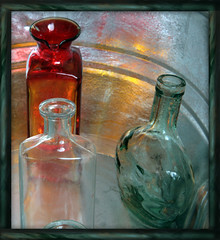- in Green Home by Alexis Rodrigo
Glass Recycling Explained
Apart from its breakability, glass is one of my favorite materials to store, cook and serve food in. It doesn’t absorb stains, tastes and odors. It’s attractive and eco-friendly to boot.
Glass can be recycled indefinitely. It is one of the oldest recyclable, man-made materials on Earth; ancient Egyptians made glass, and broken glass was melted down and reused. It can be made into an amazing number of items, including an alternative to pavement (“glassphalt”), construction sand, containers, bottles, lenses, and other items.
But how does all this happen? What happens when your glass gets to the recycling center? Here is a brief explanation of what happens to all that glass.
1. Separated into colors
[ad#ad-2] Once pigment is added to glass, it can not be removed. Thus, green glass can only be used to make green glass items, brown glass can only be recycled into brown colored items, etc. This is why the recycling plant separates glass by color. If glass is contaminated – i.e., colors have been mixed or foreign materials have smirched the glass batch – then it can be used to make insulation or other items where color and purity are unimportant.This is a good reason to take care not to mix unrecyclable glass with recyclable, or even to mix certain recyclables. Light bulb glass, for example, should not be included with glass bottles.
2. Crushing
The separated glass is then crushed by machine, and is then called “cullet.” The cullet is mixed with soda ash, silica sand, and limestone. (These are the ingredients used to make glass as well.) Then the cullet is sent to the furnace.
3. Heating
The cullet mixture is heated in a furnace until it is a red-hot, thick liquid about the consistency of honey.
4. Molding
The liquid glass is then poured into molds. Air is blown into the molds to make the proper shape. Some glass is hand-blown and made into artistic pieces, decorative bowls, Christmas ornaments, etc.
5. Shipping
The new glass containers are then shipped to various businesses where they are sold as-is or filled with various liquids, foods, etc. The entire process – from drop-off to the appearance of glass containers on shelves – can take as little as 30 days.
What else is it used for?
Glass is quite versatile. As mentioned above, it can be made into “glassphalt” and construction sand. In fact, glass is made from sand and can be ground back into that material easily. It can be “spun” into thin, flexible threads (fiberglass) and pressed into insulation. Glass is a versatile material, and using it doesn’t put a lot of strain on the Earth.
If you liked this post, submit your email address below to get new posts by email:

